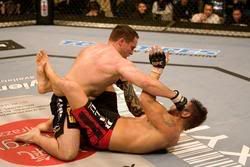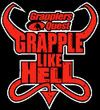A history of violence

By Ryan Pike
The rise of mixed martial arts
Fans of physical violence have been ignored for years. Boxing is fixed, wrestling is staged and fights in hockey are few and far between. Luckily for combat enthusiasts, the last decade has seen the rise of a new sport--mixed martial arts--that has taken the world by storm. Combining elements of kickboxing, jujitsu, amateur wrestling, boxing and other combative sports, modern MMA traces its roots back to tournaments held in Brazil in the 1920s. The sport achieved brief prominence in North America in the early 1990s with the debut of the Ultimate Fighting Championship.
The brainchild of Art Davie and jujitsu expert Rorion Gracie, the Ultimate Fighting Championship was unveiled in 1993 and promoted fights under the mantra: "There are no rules!" Despite the awesome tagline, there were some rules. No biting or eye gouging were allowed, and other unsportsmanlike antics were discouraged. Early events also featured little or no divisional structure, as fights were usually designed to answer questions such as, "Can a striker beat a wrestler?" or, "Can a striker beat a wrestler with a 300 pound weight advantage?"
Unfortunately, the visceral hook of the premise was also its downfall. The sheer brutality of the matches drew criticism from many people, most notably U.S. Senator John McCain. Comparing the matches to "human cockfighting," McCain spearheaded a protest movement aimed at banning no-holds-barred fighting from every state in the country. He was eventually successful in 36 states, getting UFC events thrown off of Viewer's Choice, the main pay-per-view carrier in North America.
What followed was a long reforming process, transforming UFC from a bizarre carnival sideshow--akin to a man fighting a bear--into a legitimate sport, sanctioned and regulated by athletic commissions across the U.S. The New Jersey State Athletic Control Board established the Unified Rules of Mixed Martial Arts Combat in 2000, formalizing many conventions of the sport and providing a written code for promoters to abide by. Unfortunately, the transformation process also coincided with a period known to UFC fans as "the Dark Ages." The sport received minimal exposure, leaving the company on the verge of bankruptcy.
Bryan Alvarez has covered UFC since its early days as editor of the Figure Four Weekly newsletter.
"It was huge for awhile because it was underground and word-of-mouth," reflects Alvarez. "Then when everything sort of fell apart and we had the Dark Ages, there was a period where there were rules and there was no exposure whatsoever. The biggest pay-per-view they did in the Dark Ages involved Ken Shamrock--he was a guy who had WWE [World Wrestling Entertainment] exposure--and even at that point it was at most 200,000 buys. Most pay-per-views [were] a hell of a lot less than that."
UFC's fortunes turned a corner in early 2001 when they were purchased by boxing promoter Dana White and Stanton Casinos executives Frank and Lorenzo Fertitta. Thanks to their ties to the Nevada State Athletic Commission, the Fertittas got UFC sanctioning in Nevada--traditionally a boxing hotbed--and began to promote shows at high-profile venues like the MGM Grand and the Taj Mahal. The renewed UFC resurfaced on pay-per-view and began to build an audience, but still posted losses. Everything changed with the debut of UFC's reality television show, The Ultimate Fighter, following WWE's RAW program on Spike TV.
"The whole Spike TV deal is when everything really exploded," explains Alvarez.
"Because you had a show that was on following WWE RAW, it picked up a ton of RAW viewers. These were fans that, at the time, weren't so much into WWE's product and they're watching RAW and when it's over, here's this show with these crazy guys and it was the first season so you had Chris Leben and guys breaking doors and punching through walls and cutting promos and just real personalities. That show became a hit and that's what started the snowball rolling. Ever since that point it's just been huge."
The first UFC pay-per-view following the first season of The Ultimate Fighter, UFC 52, was bought by 280,000 fans--nearly twice as many people as the company's recent outings. By featuring prominent UFC personalities in key roles while developing new fighters and being available on basic cable throughout North America, The Ultimate Fighter greatly improved the sport's visibility to a large audience. As a result, audiences for subsequent UFC events continued to increase as the company presented big-name main events while creating new stars through The Ultimate Fighter.
"The idea wasn't, 'So-and-so won, let's throw him in with Chuck Liddell,'" remarks Alvarez. "They knew better than that. Their idea was, 'We'll have this guy fight, but we'll give him a guy that he's probably good enough to beat.' It wasn't worked or anything like that, and it wasn't fake, but it was manipulated to let these guys win a contest and then keep winning matches. That's sort of been their whole deal as far as trying to create stars. Sometimes it works, sometimes it don't. They made Anderson Silva into a star because he dominated Chris Leben. Leben isn't a world-class fighter, he just happened to be a personality and they protected him for a long time and then made enough of a name out of him... that when this guy came in and steamrolled him, all of a sudden people were like, 'My God, that guy is so great, he's a killer!'"
UFC 66, featuring a rematch between light heavyweight champion Chuck Liddell and former champion--and The Ultimate Fighter trainer--Tito Ortiz, was the company's biggest success to date, garnering over one million buys. The debut of former PRIDE--a Japanese mixed martial arts company--superstar Mirko "Cro Cop" Filipovic, the emergence of several Ultimate Fighter graduates as bonafide title contenders and the recent purchase of PRIDE by the Fertittas has the UFC primed for another breakout year.
"I think this year could be bigger than last year," suggests Alvarez. "[When Lidell and Ortiz fought] and it did a million buys, I thought "Okay, this is huge. I don't know where they can go from here. Who can do a buy rate like this?" Now that Randy Couture won the [heavyweight] title, you've got Couture and Cro Cop as a possibility down the road if Cro Cop beats Gonzaga. You've got Cro Cop and Liddell. You've got Liddell and Couture. They've got two or three matches this year that if things go well, you've got an easy million buys and maybe significantly more than that."
(Source)






















No comments:
Post a Comment